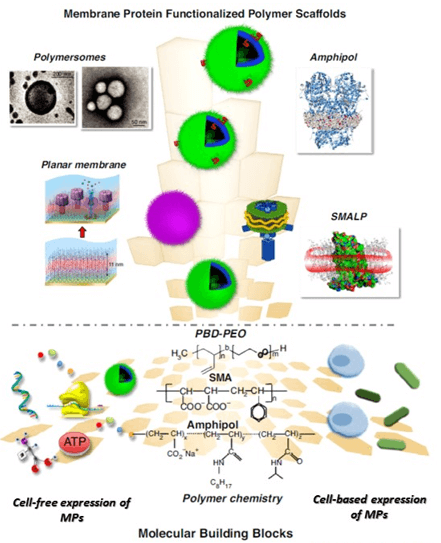Polymer Incorporation
Creative Biostructure is specialized in membrane protein purification and characterization. Polymer incorporation is one of the few powerful tools that is used for such purposes. To study the biochemical and biophysical properties of membrane proteins, it is necessary to isolate them from their native amphipathic environments and incorporate them into an artificial matrix to preserve their native structural integrity and function. Besides liposomes and Nanodiscs, polymer-based scaffolds have also been developed as reliable strategy to stabilize and present membrane proteins in a functional format.
Compared with other commonly used methods, self-assembling amphiphilic polymer-based vesicles provide several advantages:
- High chemical diversity
- Highly tunable membrane properties, such as bilayer thickness, hydrophobicity, rigidity and permeability
- Long-term stability
- Elongated circulation time in vivo
- Mimic and fabricate other scaffolds employed in preserving the structural integrity of membrane proteins
It is never easy to achieve a successful insertion of proteins into polymer-based membranes. Luckily, experts at Creative Biostructure obtained comprehensive knowledge and years of experience to solve different challenges to design polymer-based membranes for a specific target protein. These advantages ensure outstanding results for the target proteins incorporated in polymer scaffolds:
- High purity and stability
- Proper permeability
- Modified mechanical properties
- Optimized surfaces
- Correct sizes
Incorporation of membrane proteins into polymer membranes can be mainly classified into two categories: reconstitution by detergent removal and co-translational insertion. In the reconstitution method, membrane proteins are first extracted from cell-based expression system via detergent-mediated membrane solubilization, and then reconstituted into supporting vesicular or planar membranes by detergent removal. Co-translational insertion, on the other hand, relies on the simultaneous mRNA translation and membrane insertion during cell-free expression system.
The polymer-based supporting platforms include polymeric membranes (e.g. polymersome and planar membrane), amphipol (e.g. A8-35) and styrene maleic anhydride (SMA)-encircling lipid particle (SMALP). All platforms use different amphiphilic polymers.
- For polymeric membranes, the most common amphiphilic copolymers used in combination with biomolecules consist of hydrophilic blocks, such as PAA, PEO, PEG, PMOXA, or PIAT, and a hydrophobic block, such as PB, PBD or PDMS. Typical examples are PBD-PEO polymersomes and PMOXA-PDMS-PMOXA membranes.
- Amphopols are a class of amphiphilic polymers that adsorb onto the hydrophobic transmembrane surface of membrane protein through their hydrophobic part and keep the complexes water-soluble through their hydrophilic part. Amphipol-trapped membrane proteins are therefore more stable than detergent-solubilized ones.
- SMA is a synthetic polymer that is built-up of hydrophobic styrene and hydrophilic maleic anhydride monomers. It can be used to encapsulate membrane proteins reversibly.
Creative Biostructure provide the best solutions to stabilize custom membrane proteins in polymer scaffolds. We develop cell-based reconstitution or cell-free co-translational insertion strategies based on each target protein. With advanced knowledge and years of experience, we have been a reliable partner in studies of challenging targets, such as GPCRs, ion channels, transporters, porins and others. In addition to expression and purification, we also provide characterization assays with our most cutting-edge equipment, such as electron microscopy (EM) and fluorescence spectroscopy (FS). Creative Biostructure offers professional one-stop services for our customer:
- Methodologies of custom protein incorporation
- Polymeric structure construction
- Protein expression and isolation
- Protein incorporation
- Characterization assays
- Synthesized Polymeric Bilayers
References
- Hu, Z., Ho, J.C.S., Nallani, M. (2017) Synthetic (polymer) biology (membrane): functionalization of polymer scaffolds for membrane proteins. Current Opinion in Biotechnology. 46(1): 51-56.
- Garni, M., Thamboo, S., Schoenenberger, C.-A., Palivan, C.G. (2017) Biopores/membrane proteins in synthetic polymer membranes. Biochimica et Biophysica Acta-Biomembranes. 1859(4): 619-638.
 Figure 1. Polymeric supports for membrane proteins that are assembled from various building blocks (polymer molecules, MPs expressed by different methods). (Current Opinion in Biotechnology 2017)
Figure 1. Polymeric supports for membrane proteins that are assembled from various building blocks (polymer molecules, MPs expressed by different methods). (Current Opinion in Biotechnology 2017)
